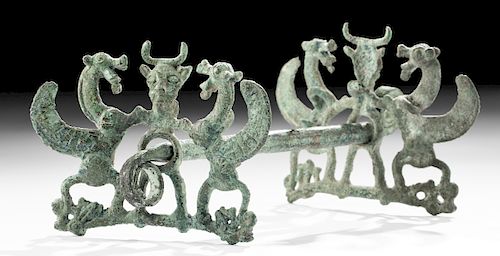Luristan Bronze Horse Bit with Master of Animals
Lot 70
About Seller
Artemis Fine Arts
686 S Taylor Ave, Ste 106
Louisville, CO 80027
United States
Selling antiquities, ancient and ethnographic art online since 1993, Artemis Gallery specializes in Classical Antiquities (Egyptian, Greek, Roman, Near Eastern), Asian, Pre-Columbian, African / Tribal / Oceanographic art. Our extensive inventory includes pottery, stone, metal, wood, glass and textil...Read more
Categories
Estimate:
$12,000 - $18,000
Absentee vs Live bid
Two ways to bid:
- Leave a max absentee bid and the platform will bid on your behalf up to your maximum bid during the live auction.
- Bid live during the auction and your bids will be submitted real-time to the auctioneer.
Bid Increments
| Price | Bid Increment |
|---|---|
| $0 | $25 |
| $300 | $50 |
| $1,000 | $100 |
| $2,000 | $250 |
| $5,000 | $500 |
| $10,000 | $1,000 |
| $20,000 | $2,500 |
| $50,000 | $5,000 |
| $100,000 | $10,000 |
| $200,000 | $20,000 |
About Auction
By Artemis Fine Arts
Feb 13, 2020
Set Reminder
2020-02-13 10:00:00
2020-02-13 10:00:00
America/New_York
Bidsquare
Bidsquare : Exceptional Antiquities, Asian, Ethnographic
https://www.bidsquare.com/auctions/artemis-gallery/exceptional-antiquities-asian-ethnographic-4848
An important one-day auction featuring museum-worthy examples of Egyptian, Greek, Roman, Etruscan, Near Eastern, Far East / Asian, Pre-Columbian, African / Tribal, Oceanic, Native American, Spanish Colonial, Russian, Fossils, Ancient Jewelry, Fine Art, so much more! Artemis Fine Arts info@artemisgallery.com
An important one-day auction featuring museum-worthy examples of Egyptian, Greek, Roman, Etruscan, Near Eastern, Far East / Asian, Pre-Columbian, African / Tribal, Oceanic, Native American, Spanish Colonial, Russian, Fossils, Ancient Jewelry, Fine Art, so much more! Artemis Fine Arts info@artemisgallery.com
- Lot Description
Ancient Near East, northwestern Iran, Luristan, ca. 8th century BCE. An elaborate horse bit decorated with cheek pieces that incorporate an openwork three-figure scheme; in the center, the horned Master of Animals stands, flanked by two winged mythical beasts, rearing up on their hind legs, their jaws agape and tongues lolling. The Master of Animals motif, in which a human or godlike figure grasps two confronted animals, was widespread in the iconography of the Ancient Near East and Egypt, and is one of the most popular in Luristan. It is symbolic of the complex relationship between the natural world and the nomadic peoples, whose lives were centered around herding, animal husbandry and hunting. Size: 7.1" L x 4.25" W x 3" H (18 cm x 10.8 cm x 7.6 cm)
It is also possible that particular forms and animals denoted that the owner belonged to a certain tribe. The emergence and popularity of so-called 'animal art' may have been a manifestation of shamanism, which was practiced by various nomadic tribes. In some instances, the shaman was transformed into an animal which the tribe then adopted as their totem. This animal totem then became the ideal of the tribe, and the motif of animals in combat may be an allusion to the totem of one tribe subduing the totem of another.
Luristan is a province in central western Iran. It comprises an area of plains surrounded by the high ranges of the Zagros mountains and has supported a population of nomadic peoples and mountain communities for thousands of years. Bronze working in this region is known from as early as 3000 BC, but it is during the ninth to seventh centuries, from which period the present piece dates, that it reached the pinnacle of its craftsmanship in this medium. Luristan was set apart from its neighboring regions by the prolific appearance of elaborately decorated cast ornaments, including standard finials, horse trappings and pins, usually incorporating stylized animal and anthropomorphic motifs. The bronze workers of Luristan excelled particularly in producing decoration for horses, at a time when cavalry was eclipsing chariotry as the main mobile force in many Near Eastern armies. The relatively sudden emergence of this new artistic style is generally considered to have been initiated by a group of newcomers to the area, probably a nomadic people; their dependency on movement for their way of life meant that many forms of material wealth presented a conceptual and physical impediment. For this reason, expressions of status, conveyed by artistic virtuosity, are contained in portable objects of personal adornment or military utility.
A cheekpiece with a similar scheme is at the Cleveland Museum of Art, inv. no. 1961.33.
Provenance: private Connecticut, USA collection; ex-New York, USA private collection, 1990s
All items legal to buy/sell under U.S. Statute covering cultural patrimony Code 2600, CHAPTER 14, and are guaranteed to be as described or your money back.
A Certificate of Authenticity will accompany all winning bids.
We ship worldwide and handle all shipping in-house for your convenience.
#152766Beautifully preserved, intact with slight bending to the cheek pieces. Lovely green and azurite blue patina that does not obscure the details of the piece.Condition
- Shipping Info
-
All shipping is handled in-house for your convenience. Your invoice from Artemis Gallery will include shipping calculation instructions. If in doubt, please inquire BEFORE bidding for estimated shipping costs for individual items.
-
- Buyer's Premium



 EUR
EUR CAD
CAD AUD
AUD GBP
GBP MXN
MXN HKD
HKD CNY
CNY MYR
MYR SEK
SEK SGD
SGD CHF
CHF THB
THB














